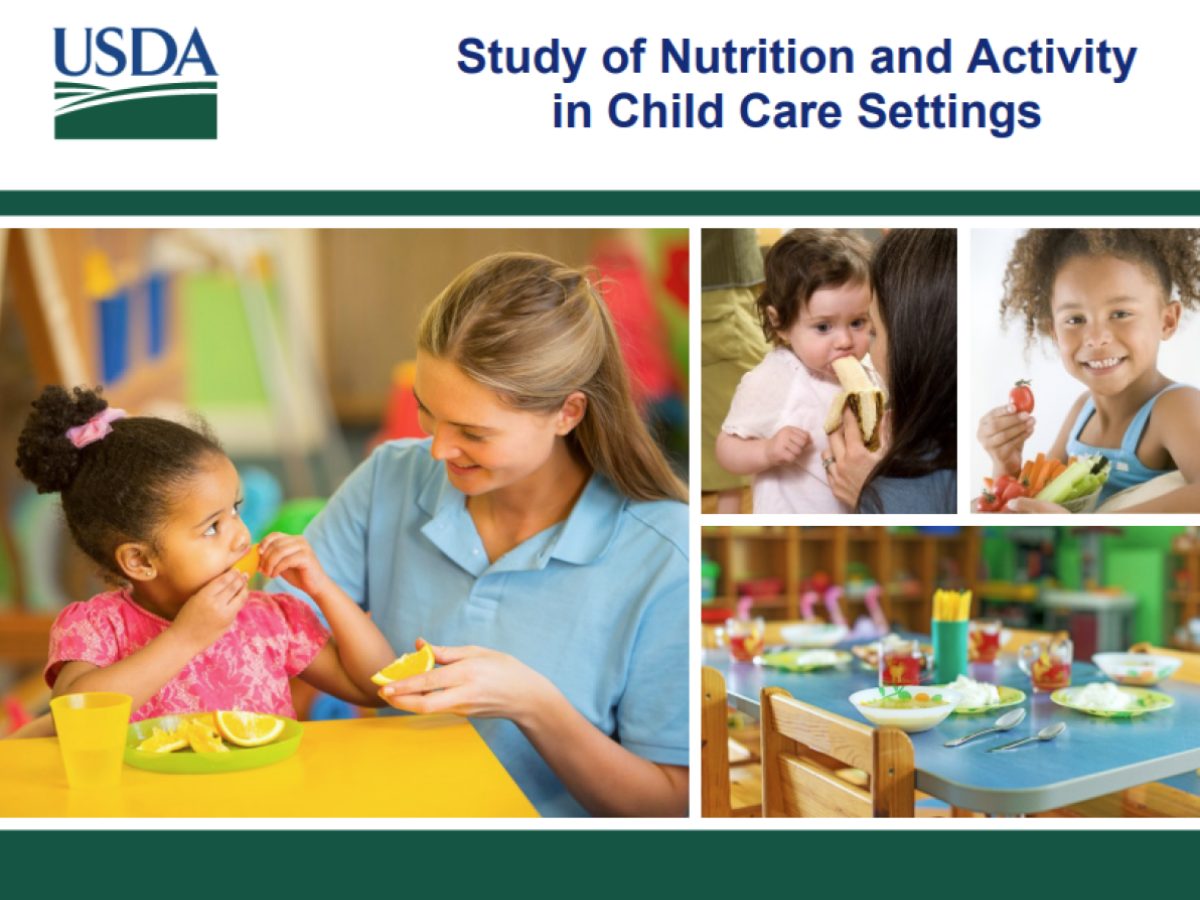Study of Nutrition and Activity in CACFP
December 8, 2022

Study of Nutrition and Activity in Childcare Settings Summary
In October 2021 the USDA released a report on the Study of Nutrition and Activity in Child Care Settings (SNACS), which is the first nationally representative, comprehensive assessment of the CACFP. Data was collected on:
- Wellness policies and practices of childcare providers
- Nutritional quality of the meals served in CACFP
- CACFP meal costs and revenues
- Nutrient intake of infants and children in CACFP childcare settings and outside of childcare
- Observed plate waste in CACFP settings
Why it Matters
CACFP operators have an opportunity to support healthy behaviors among young children through the meals they serve and the food and wellness environments they provide. Furthermore, CACFP policies and practices can help promote good early dietary habits and have the potential to affect the well-being of all children in their care. The data collated in the SNACS report can be used to identify areas of CACFP that are lacking, in order to provide solutions to enhance program success. In addition, the report highlights the great work being done by CACFP operators, as well as the importance of CACFP in promoting nutrition security.
Early Care Program Findings (3-5-year-olds)
Wellness Policies and Practices
- Nearly all (99%) programs provided at least one physical activity opportunity, with a mean of 12 minutes per hour devoted to physical activity opportunities.
- Most programs (60%) had menu planners with over 10 years of experience; however, this varied by program type.
Quality of Meals Served
- The majority of lunches (88%), breakfasts (97%), and afternoon snacks (97%) served included all required meal components.
- CACFP lunches served had a mean Healthy Eating Index (HEI) score of 73 out of 100 and breakfasts had a mean score of 67 out of 100. The scores indicate that the meals served do not align with the Dietary Guidelines for Americans (DGAs). However, CACFP meals were healthier than the average young child’s diet.
Cost and Revenue
- The median total cost (labor plus food costs) per meal served was $4.19 for breakfast, $4.85 for lunch, and $2.94 per snack. Labor costs were substantially greater than food costs, amounting to 69-79% of the total costs.
- USDA subsidies, including cash-in-lieu, covered between 18-51% of total costs per meal. On average, the subsidies covered just 29% of the total cost to produce breakfast, 51% of the total cost for lunch, and 18.2% of the total cost to produce snack.
- About half of all labor costs for breakfast (53%), lunch (49%), and snack (48%) went toward serving and cleaning up after meals. Only a quarter of labor costs went towards meal production.
Children’s Dietary Intakes
- Children’s dietary intake was significantly more aligned with the 2015 DGAs on a childcare day compared to a non-childcare day.
- HEI scores for total vegetables and whole grains were fairly low in general but were significantly higher on childcare days than non-childcare days.
- On average, 3- to 5-year-olds did not consume 29 percent of calories served at breakfast, 26 percent of calories at lunch, and 22 percent of calories at afternoon snack.
Before and After School Program Findings (6–12-year-olds)
Wellness Policies and Practices
- The majority of before and after school programs (88%) provided at least one physical activity opportunity session, with a mean of 21 minutes per hour.
Quality of Meals Served
- The most common meal types served in before and after school care settings were suppers (served in 67% of the programs) and afternoon snacks (47%). The majority of suppers (91%) served provided all of the required components. Close to all afternoon snacks (97%) included all required components.
- The suppers served in before and after school programs had a mean total HEI-2015 score of 76 out of 100. Four of the nine adequacy components were near perfect or perfect scores, indicating maximum alignment with the DGAs: total fruits, whole fruits, dairy, and protein foods.
Cost and Revenue
- The median total cost per meal was $4.00 per supper and $2.66 per snack. Labor costs were on average greater than food costs, with median labor costs accounting for 59 percent of the total cost of supper and 78 percent of the cost of snacks.
- Contrary to the findings from early care programs, about half of all labor costs for supper and snacks went to administrative labor (51% and 46%, respectively). Serving and cleaning made up 27% of labor costs at supper and 37% of labor costs for snacks, while meal production labor made up 23% of labor costs for supper and 18% of labor costs for snacks.
- While USDA subsidies covered, on average, 185% of the food costs for suppers and 126% of the food costs for snacks, they covered just 84% of total costs (food and labor costs combined) for suppers, and only 27% of total costs for snacks.
Infant Findings
Milk Feeding
- Over two-thirds of infants under 12 months of age (69%) consumed only infant formula while in childcare on a single target day. 23% consumed only breastmilk and 7% consumed a combination of both.
Complementary Feeding Among Infants
- Early care programs served a variety of foods to infants to complement the milk feeding. More than half of infants ages 6 to 11 months consumed grains (70%), vegetables (70%), and fruits (62%) at least once during a single childcare day.
For more details, read the Study of Nutrition and Activity in Childcare Settings in USDA’s Child and Adult Care Food Program (SNACS).
